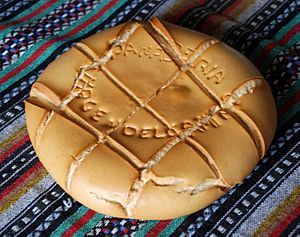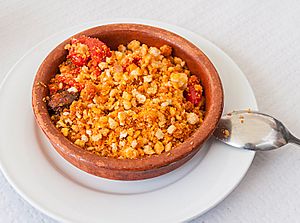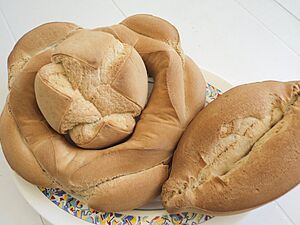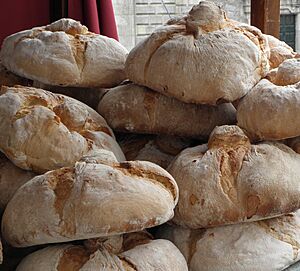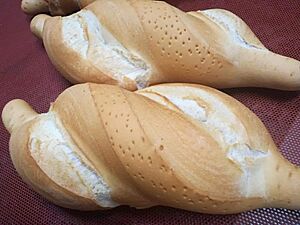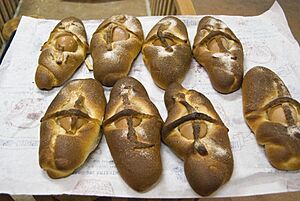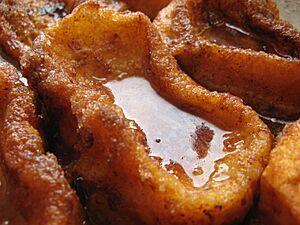Bread culture in Spain facts for kids
Bread in Spain has a very old history with many different types made in each region. Wheat is the most grown grain because it grows well in Spain's dry climate. For a very long time, bread (called pan in Spanish) has been a main food eaten with every meal, all year. Spain is one of the European places with the most kinds of bread. The simple barra (like a baguette) is the most popular type of bread, making up 75% of what people eat.
A food expert named José Carlos Capel guessed there are about 315 different kinds of bread in Spain! Besides being food, bread in Spain has special roles in history, culture, religion, and old stories.
One special Spanish bread is called candeal, bregado, or sobado bread. It has a long history in places like Castile, Andalusia, Extremadura, Araba, Valencia, and Zaragoza. This bread is made from Candeal wheat flour. This special kind of durum wheat grows only in Spain and the Balearic Islands. The dough for this bread is made by pressing it with a machine called a bregadora, which is like a pasta maker. You can only find pan sobado bread in Spain and Portugal (where it's called pão sovado).
In southern Spain, people prefer white flour for bread. This makes the bread soft and light. In northern Europe, brown breads are more common. This is because wheat is very important in Spanish baking. In other parts of Europe, people often mix wheat with rye flour or other grains. Wholemeal breads (made with whole grain flour) only became popular recently in Spain. This happened when people started to care more about healthy eating. For a long time, breads made from rye, barley, or whole wheat were seen as "food for the poor."
Bread is also used in many Spanish recipes! Some examples are ajoblanco, preñaos, migas, pa amb tomàquet, salmorejo, and torrijas. Traditional Spanish cuisine often uses simple ingredients to make tasty meals. Bread is a key ingredient, especially in the middle of the country. Spanish people have always eaten a lot of bread. However, people are eating less bread now. Also, bread making is becoming more machine-made, and old traditions are getting simpler.
Contents
How Did Bread Become So Important in Spain?
Bread was made in Spain even before the Romans arrived. The Iberian people grew wheat and other grains like einkorn wheat and barley. They even knew how to make dough rise. The idea of bakeries as shops came from the Greeks. The Romans then made big improvements to tools like mills and ovens. Many "bread stamps" (called signa pistoris) have been found across Hispania (old Spain). These stamps were used by Romans to mark bread for religious reasons. Interestingly, stamps found in central Europe often showed symbols of the emperor, but in Spain, they showed symbols from Roman mythology.
In Rome, bakers made dough rise by using leftover dough from previous days (called sourdough). But in Spain, people used beer foam as yeast. This made their breads lighter and fluffier. Pliny the Elder, a Roman writer and soldier, once worked in Spain. He said that "Hispania's bread is very light and very pleasing to the palate."
During the Andalusian period (from the 8th to the 15th century), growing grains was the main job. Bread was a basic daily food. In Al-Andalus, they made white bread from wheat flour. They also made a cheaper, coarser bread with bran, called "red bread." On the Christian side of the border, being a baker became a respected job in medieval society. To control the market, bakers started forming groups called guilds from the 12th century. In Spain, especially near the Mediterranean Sea, bakers' guilds have existed for over 750 years. For example, the Guild of Bakers of Barcelona is mentioned in a document from 1395.
When Spain explored America, they brought back a new grain: corn. Corn is now used in bread in "Green Spain" (northern Spain). An example is borona, brona, or broa. This is a typical corn bread from Galicia, Asturias, Cantabria, and the Basque Country.
What Are Some Spanish Breads?
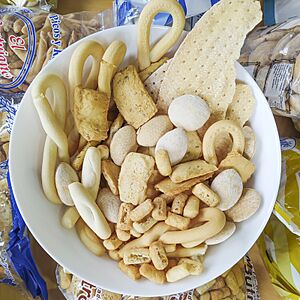
Here is a short list of some popular breads in Spain:
- Pan de payés (Pa de pagès in Catalan), from Catalonia
- Pan gallego (Pan galego in Galician), from Galicia
- Pan de Alfacar, in Andalusia
- Pan cateto, in Southern Andalusia
- Bollo, from Seville
- Candeal, bregado or sobado, from Castile and many other regions
- Cañada bread, a flatbread with olive oil, from Aragón
- Mollete, from Antequera, Málaga
- Pan de cruz, from Ciudad Real
- Pan de la Mota, from Mota del Cuervo, Cuenca
- Carrasca, from Murcia
- Pataqueta, from the Valencian Community
- Telera, from Córdoba
- Taja, from Navarre
- Colón and Fabiola, from Castile and Leon
- Llonguet, a roll from Catalonia and the Balearic Islands
- Francesilla, from Madrid
- Pistola, from Madrid
- Broa, borona, from Northern Spain
Some breads have toppings:
Some breads have fillings:
- Hornazo
- Galician empanada
- Bollo preñao
Sweet breads:
- Roscón de Reyes
- Jallulla, from Granada
- Pan de cañada, from Aragón
- Torta de Aranda
- Ensaimada, from Mallorca
- Toña, tonya, fogaza, fogassa, mona or panquemao
- Txantxigorri cake
Bread's Role in Spanish Culture
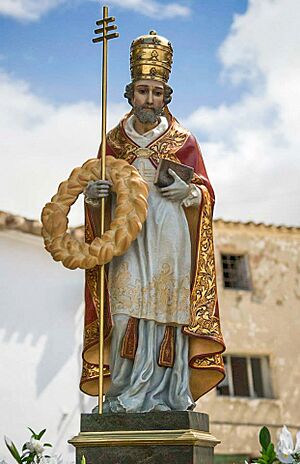
Bread is more than just food; it has special meaning in traditions and religion. In Christianity, bread is seen as the body of Christ. With wine, it forms the Eucharist in churches. Even before Christianity, many old traditions (like Celtic, Greco-Roman, and Phoenician) saw bread as a sign of new life and growth. For example, in Ancient Rome, people offered bread to Ceres, the goddess of crops. Christianity took some of these old traditions, as well as ideas from Judaism, where bread is also very important.
Bread and Spring Traditions
Eggs are another food that many old cultures linked to new life. So, it's not surprising that some traditions continue today. During spring, which is also linked to birth and life, people bake whole eggs into bread dough. Examples include the Catalan monas, the Basque opillas, and the Castilian San Marcos hornazo. The egg is often tied to the bread with two strips of dough shaped like a cross. This connects an old custom with Christian ideas.
Bread and Remembering Loved Ones
Bread has been part of funeral traditions since ancient times. As an offering, bread has represented death in many cultures around the Mediterranean Sea and beyond. In the past, it was common to give out loaves of bread at funerals. An expert named Joan Amades said that at funerals, people would offer rolls to the priest along with a candle. When someone died, it was believed that "there should be bread in the house to help the journey."
In Catalonia, on All Souls' Day (November 2), people believe the dead visit their families. They offer a special bread called pa d'ànimes ('bread of souls'). Today, smaller breads like panets and panellets are more common. This tradition is also found in Mexico, called "bread of the dead." In some Catalan towns, after a funeral, a bread with a cross in the middle, called pa de memòria, is served. It is dedicated to the person who passed away with a prayer. These "breads of the dead" can be found across Spain and the Mediterranean. Examples include pan de finado from the Canary Islands, "saint's bones" from Madrid, and human-shaped breads from Sicily, Italy.
Bread at the Table
In Spain, Christian families often bless bread before a meal. They thank God for "giving us our daily bread" and make a cross on the crust. It was a custom not to eat the first slice yourself. Instead, a good Christian would give the first piece to their guests. The importance of bread at the Christian table is shown by the marks sometimes stamped on loaves. These marks might say things like Viva el Pan Bendito ("Long live the blessed bread") or Soy el Principal de la mesa ("I am the main one at the table"). Wasting or throwing away bread was seen as disrespecting this important food.
Changes in Bread Culture and How It's Being Saved
Bread has always been the most eaten food in Spain. But its importance changed in the 1960s and 1970s. At that time, farming became more modern, and Spain connected more with the rest of the world. People started eating less bread, and its quality and traditions began to fade. A food researcher named Ibán Yarza traveled through Spain's 50 provinces to learn about its baking history. He said, "Bread has lost its special status. It used to be sacred because it was eaten the most. Now, less bread is eaten than ever before." This change is similar to what happened to the Mediterranean food traditions in nearby Italy.
Starting in the 2010s, people in Spain began to show new interest in traditional Spanish baking. This movement is still new, but it has already led to famous names. For example, Lucía Etxebarría from El Horno de Babette in Madrid has one of the most popular YouTube channels about baking in Spanish. Also, the Turris bakery chain in Barcelona, run by Xavier Barriga, has written several baking books. Since 2017, an organization called Panàtics has held the "Route through Spain of good bread." This is an annual event that picks one hundred of the best artisan bakeries in Spain. In 2019, Spain even passed a law (Royal Decree 308/2919) to set standards for bread quality.
How Spanish Bread Influenced the World
In Europe
The candeal, bregado, or sobado bread started in what is now Castile and León. It then spread south to Portugal, where it has also been made for a very long time. In Portuguese, it's called pão sovado in the north or pão de calo in the south.
Sobado bread was given to soldiers because it stays fresh for days, even weeks. It reached French Normandy through the Kingdom of Navarre during the time of Charles II 'the Bad'. He was married to Joan of France. This led to the Norman pain brié, which is very similar to candeal bread. Later, Spanish soldiers called Tercios brought sobado bread to France, Italy, Flanders, and other parts of Europe. Italian bakers adopted Spanish sobado bread and created their own delicious breads, like coppia ferrarese. Even in the Maghreb region of North Africa, there is a bread called pain espagnole that comes from candeal. However, what Italians call pan di Spagna ("Spanish bread") is actually sponge cake. Italian tradition says it was made by a baker in Spain. This name has also spread to Greek (pantespani) and Turkish (pandispanya).
In the Americas
Spanish baking is the foundation of today's Latin American baking. Recipes were later changed to fit the local climate, ingredients, and tastes.
Wheat was one of the first foods brought to the New World by the Spanish. The culture of bread was also one of the first things the Spanish colonizers introduced to the native people's diet. This happened even though corn was already a main food. Growing a lot of wheat in America also had a political reason. The Spanish wanted to control how it was grown, shared, and sold. Some native groups resisted growing wheat as a way to fight Spanish rule. For example, Antonio de Mendoza complained that native people ignored growing wheat. This was partly because they used the same tools as for corn, and wheat didn't grow well that way. Still, bread culture eventually became part of life in America, helped by Spanish missions.
Today, Spanish-style baking is found all over the Americas. Bread is a common food, with different types depending on the country and region. For example:
- Spanish torrijas are also eaten in Argentina, Chile, Colombia, and Costa Rica, among other countries.
- In Mexico, a bread called telera has its roots in the telera that workers in Andalusia, Spain, used to eat. In the Dominican Republic, there is also a telera that is popular at Christmas.
- The acemita was a bread eaten in Spain that was considered low quality. It was made with wheat bran (sometimes mixed with a little white flour). The mixture itself was called acemite, and it was used to make "poor man's bread." Because of a Spanish accent change called seseo, the word became semita. This is now the name for many typical breads in different states of Mexico, as well as in Honduras, Argentina, and El Salvador.
In the Philippines
Spanish traditions also form the basis of Filipino baking. The common bread is called pandesal ('salt bread' in Spanish). A bread filled with red pudding is called pan de regla. Pan de coco ('coco bread') is also eaten in Latin America. Interestingly, a bread called Spanish bread in the Philippines is actually from native Filipino traditions.
See also
 In Spanish: Cultura del pan en España para niños
In Spanish: Cultura del pan en España para niños


